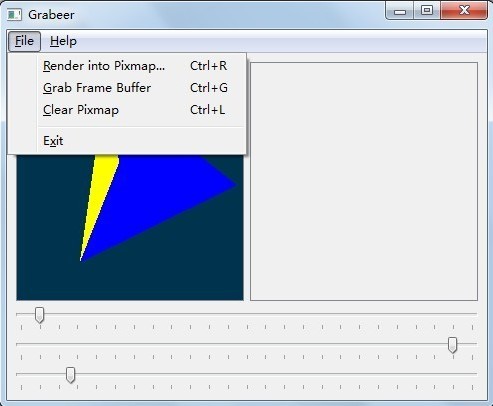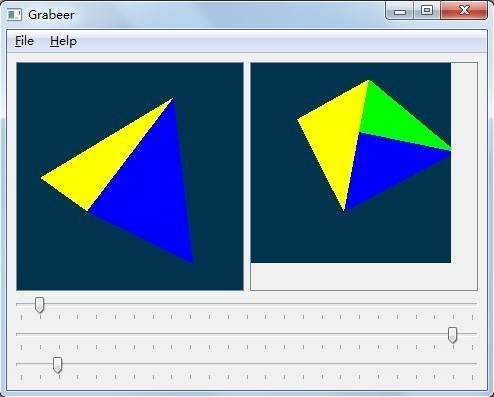Qt學習:三維繪圖之OpenGL和Qt的結合
OpenGL是繪製三維圖形的標準API。Qt應用程式可以使用QtOpenGL模組繪製三維圖形,該模組依賴於系統的OpenGL庫。Qt OpenGL模組提供QGLWidget類,可以通過對它子類化,並使用OpenGL命令開發出自己的視窗部件。對許多三維應用程式來說,這就足夠了。
這節假設大家都已經學過OpenGL,這樣我們就無後顧之憂了。
在Qt中繪製OpenGL通常需要做以下工作:1)、必須子類化QGLWidget;2)、實現幾個虛擬函式:void initiallizeGL()
void resizeGL(), void paintGL(), 這些都是在QGLWidget中實現的,還有一些和使用者互動的虛擬函式,諸如void mouseMoveEvent()之類的,想必大家都比較熟了,這些虛擬函式是在Widget中實現的。
下面我們介紹一個例子。先給出該程式的效果:
選單欄裡的第一項可以完成一個自定義大小的抓圖,即由使用者自己決定抓圖的大小,抓圖會顯示在右側的方框裡,注意這裡只能設定圖形的大小小雨當前圖形的尺寸, 如果大於當前圖形尺寸,則鉗位到當前圖形尺寸。效果看起來應該是這樣:
選單欄第二項也是一個抓圖功能,它返回一個當前圖形尺寸的圖形,並填充到右側。
第三項即清除右側圖形。
這個程式碼由以下部件構成:
一個QMainWindow,我們通過子類化這個類來完成自己想要的一些功能。
一個QWidget,我們把它作為中央視窗,在其上新增自己想要的一些子部件。
兩個QScrollBar,用來盛載一個QGLWidget和一個QLabel。
一個QGLWidget,我們通過子類化它並把它加進一個QScrollBar來實現三維繪圖,即上圖所示的左邊視窗。
一個QLabel,同樣,我們把這個QLabel加進一個QScrollBar來接收抓圖後的顯示效果。
三個QSlider,我們通過這三個滑動條控制所繪製的四面體沿x,y,z軸轉動,同樣滑鼠拖動這個四面體也可以改變滑動條的值。
以上是整個程式的框架。
以下是程式碼的實現部分。
MainWindow 類定義了我們整個程式的框架:
//mainwindow.h #ifndef MAINWINDOW_H #define MAINWINDOW_H #include <QMainWindow> class QAction; class QLabel; class QMenu; class QSlider; class QScrollArea; class GLWidget; class MainWindow : public QMainWindow { Q_OBJECT public: MainWindow(QWidget *parent = 0); ~MainWindow(); private slots: void renderIntoPixmap(); void grabFrameBuffer(); void clearPixmap(); void about(); private: void createMenus(); void createActions(); QSlider *createSlider(const char *changedSignal, const char *setterSlot); void setPixmap(const QPixmap &pixmap); QSize getSize(); QWidget *centralWidget; QScrollArea *glWidgetArea; QScrollArea *pixmapLabelArea; GLWidget *glWidget; QLabel *pixmapLabel; QSlider *xSlider; QSlider *ySlider; QSlider *zSlider; QMenu *fileMenu; QMenu *helpMenu; QAction *renderIntoPixmapAction; QAction *grabFrameBufferAction; QAction *clearPixmapAction; QAction *exitAction; QAction *aboutAction; QAction *aboutQtAction; }; #endif // MAINWINDOW_H
以下是程式的實現部分:
//mainwindow.cpp
#include <QtOpenGL>
#include <QAction>
#include <QLabel>
#include <QMenu>
#include <QSlider>
#include <QScrollArea>
#include <QMenuBar>
#include <QApplication>
#include "mainwindow.h"
#include "glwidget.h"
MainWindow::MainWindow(QWidget *parent)
: QMainWindow(parent)
{
centralWidget = new QWidget;
setCentralWidget(centralWidget);
glWidget = new GLWidget;
pixmapLabel = new QLabel;
glWidgetArea = new QScrollArea;
glWidgetArea->setWidget(glWidget);
//glWidgetArea->viewport()->setBackgroundRole(QPalette::Dark);
glWidgetArea->setWidgetResizable(true);
glWidgetArea->setHorizontalScrollBarPolicy(Qt::ScrollBarAlwaysOff);
glWidgetArea->setVerticalScrollBarPolicy(Qt::ScrollBarAlwaysOff);
glWidgetArea->setSizePolicy(QSizePolicy::Ignored, QSizePolicy::Ignored);
glWidgetArea->setMinimumSize(50, 50);
pixmapLabelArea = new QScrollArea;
pixmapLabelArea->setWidget(pixmapLabel);
pixmapLabelArea->setSizePolicy(QSizePolicy::Ignored, QSizePolicy::Ignored);
pixmapLabelArea->setMinimumSize(50, 50);
//在構造一個QSlider時將QGLWidget的訊號和槽傳給這個函式的形參,這樣就可以在QMainWindow中
//控制OpenGL的動作了,而讓GLWidget類只完成繪圖工作。
xSlider = createSlider(SIGNAL(xRotationChanged(int)),
SLOT(setXRotation(int)));
ySlider = createSlider(SIGNAL(yRotationChanged(int)),
SLOT(setYRotation(int)));
zSlider = createSlider(SIGNAL(zRotationChanged(int)),
SLOT(setZRotation(int)));
/*
xSlider = new QSlider(Qt::Horizontal);
ySlider = new QSlider(Qt::Horizontal);
zSlider = new QSlider(Qt::Horizontal);
*/
QGridLayout *centralLayout = new QGridLayout;
centralLayout->addWidget(glWidgetArea, 0, 0);
centralLayout->addWidget(pixmapLabelArea, 0, 1);
centralLayout->addWidget(xSlider, 1, 0, 1, 2);
centralLayout->addWidget(ySlider, 2, 0, 1, 2);
centralLayout->addWidget(zSlider, 3, 0, 1, 2);
centralWidget->setLayout(centralLayout);
createActions();
createMenus();
xSlider->setValue(15 * 16);
ySlider->setValue(345 * 16);
zSlider->setValue(0 * 16);
setWindowTitle(tr("Grabeer"));
resize(480, 360);
}
void MainWindow::setPixmap(const QPixmap &pixmap)
{
pixmapLabel->setPixmap(pixmap);
QSize size = pixmap.size();
if (size - QSize(1, 0) == pixmapLabelArea->maximumViewportSize())
size -= QSize(1, 0);
pixmapLabel->resize(size);
}
QSize MainWindow::getSize()
{
bool ok;
QString text = QInputDialog::getText(this, tr("Grabber"),
tr("Enter Pixmap Size:"),
QLineEdit::Normal,
tr("%1 x %2").arg(glWidget->width())
.arg(glWidget->height()),
&ok);
if (!ok)
return QSize();
QRegExp regExp(tr("([0-9]+) *x *([0-9]+)"));
if (regExp.exactMatch(text)) {
int width = regExp.cap(1).toInt();
int height = regExp.cap(2).toInt();
if (width > 0 && width < 2048 && height > 0 && height < 2048)
return QSize(width, height);
}
return glWidget->size();
}
void MainWindow::renderIntoPixmap()
{
QSize size = getSize();
if (size.isValid()) {
QPixmap pixmap = glWidget->renderPixmap(size.width(), size.height());
setPixmap(pixmap);
}
}
void MainWindow::grabFrameBuffer()
{
//QGLWidget有一個返回其幀緩衝區的QImage圖片的函式
QImage image = glWidget->grabFrameBuffer();
//QPixmap的fromImage函式把一個QImage轉換成QPixmap
setPixmap(QPixmap::fromImage(image));
}
void MainWindow::clearPixmap()
{
setPixmap(QPixmap()); //給它傳一個空的物件
}
void MainWindow::about()
{
QMessageBox::about(this, tr("About Grabber"),
tr("The <b>Grabber</b> example demonstrates two approaches for "
"rendering OpenGL into a Qt pixmap."));
}
QSlider *MainWindow::createSlider(const char *changedSignal,
const char *setterSlot)
{
QSlider *slider = new QSlider(Qt::Horizontal);
slider->setRange(0, 16 * 360);
slider->setSingleStep(16);
slider->setPageStep(15 * 16);
slider->setTickInterval(15 * 16);
slider->setTickPosition(QSlider::TicksRight);
//這種經典的用法一定要小心,報錯:glWidget的槽函式在傳進來的時候已經被強制轉換成SLOT了,
//所以setterSlot不用SLOT修飾;同樣,changedSignal也不能再拿SIGNAL修飾
connect(slider, SIGNAL(valueChanged(int)), glWidget, setterSlot);
connect(glWidget, changedSignal, slider, SLOT(setValue(int)));
return slider;
}
void MainWindow::createActions()
{
renderIntoPixmapAction = new QAction(tr("&Render into Pixmap..."), this);
renderIntoPixmapAction->setShortcut(tr("Ctrl+R"));
renderIntoPixmapAction->setToolTip(tr("yes, triggerd it"));
connect(renderIntoPixmapAction, SIGNAL(triggered()),
this, SLOT(renderIntoPixmap()));
grabFrameBufferAction = new QAction(tr("&Grab Frame Buffer"), this);
grabFrameBufferAction->setShortcut(tr("Ctrl+G"));
connect(grabFrameBufferAction, SIGNAL(triggered()),
this, SLOT(grabFrameBuffer()));
clearPixmapAction = new QAction(tr("&Clear Pixmap"), this);
clearPixmapAction->setShortcut(tr("Ctrl+L"));
connect(clearPixmapAction, SIGNAL(triggered()), this, SLOT(clearPixmap()));
exitAction = new QAction(tr("E&xit"), this);
exitAction->setShortcuts(QKeySequence::Quit);
connect(exitAction, SIGNAL(triggered()), this, SLOT(close()));
aboutAction = new QAction(tr("&About"), this);
connect(aboutAction, SIGNAL(triggered()), this, SLOT(about()));
aboutQtAction = new QAction(tr("About &Qt"), this);
connect(aboutQtAction, SIGNAL(triggered()), qApp, SLOT(aboutQt()));
}
void MainWindow::createMenus()
{
fileMenu = menuBar()->addMenu(tr("&File"));
fileMenu->addAction(renderIntoPixmapAction);
fileMenu->addAction(grabFrameBufferAction);
fileMenu->addAction(clearPixmapAction);
fileMenu->addSeparator();
fileMenu->addAction(exitAction);
helpMenu = menuBar()->addMenu(tr("&Help"));
helpMenu->addAction(aboutAction);
helpMenu->addAction(aboutQtAction);
}
MainWindow::~MainWindow()
{
}
GLWidget類是整個繪圖的部分,在這部分雖然用了一點Qt的東西,但我們不是非要這樣使用,我們可以用整個純淨的OpengGL庫來完成我們的繪製。
//glwidget.h
#ifndef GLWIDGET_H
#define GLWIDGET_H
#include <QGLWidget>
class GLWidget : public QGLWidget
{
Q_OBJECT
public:
explicit GLWidget(QWidget *parent = 0);
int xRotation() const { return xRot; }
int yRotation() const { return yRot; }
int zRotation() const { return zRot; }
signals:
void xRotationChanged(int angle);
void yRotationChanged(int angle);
void zRotationChanged(int angle);
public slots:
void setXRotation(int angle);
void setYRotation(int angle);
void setZRotation(int angle);
protected:
void initializeGL();
void paintGL();
void resizeGL(int w, int h);
void mousePressEvent(QMouseEvent *event);
void mouseMoveEvent(QMouseEvent *event);
private slots:
void alwaysRotate();
void drawTriangle();
private:
void normalizeAngle(int *angle);
int xRot;
int yRot;
int zRot;
QColor faceColors[4];
QPoint lastPos;
};
#endif // GLWIDGET_H
以下是程式碼實現部分:
//glwidget.cpp
#include <QtGui>
#include <QtOpenGL>
#include <math.h>
#include "glwidget.h"
GLWidget::GLWidget(QWidget *parent) :
QGLWidget(parent)
{
xRot = 0;
yRot = 0;
zRot = 0;
faceColors[0] = Qt::red;
faceColors[1] = Qt::green;
faceColors[2] = Qt::blue;
faceColors[3] = Qt::yellow;
QTimer *timer = new QTimer(this);
connect(timer, SIGNAL(timeout()), this, SLOT(alwaysRotate()));
timer->start(70);
}
void GLWidget::initializeGL()
{
glClearColor(0.0, 0.2, 0.3, 1.0);
glShadeModel(GL_SMOOTH);
glEnable(GL_DEPTH);
}
void GLWidget::paintGL()
{
glClear(GL_COLOR_BUFFER_BIT | GL_DEPTH_BUFFER_BIT);
glPushMatrix();
drawTriangle();
glPopMatrix();
}
void GLWidget::resizeGL(int w, int h)
{
int side = qMin(w, h);
glViewport((width() - side) / 2, (height() - side) / 2, side, side);
glMatrixMode(GL_PROJECTION);
glLoadIdentity();
glFrustum(-1.2, 1.2, -1.2, 1.2, 5.0, 60.0);
glMatrixMode(GL_MODELVIEW);
glLoadIdentity();
glTranslatef(0.0, 0.0, -40.0);
}
void GLWidget::mousePressEvent(QMouseEvent *event)
{
lastPos = event->pos();
}
void GLWidget::mouseMoveEvent(QMouseEvent *event)
{
int dx = event->x() - lastPos.x();
int dy = event->y() - lastPos.y();
if (event->buttons() & Qt::LeftButton) {
(xRot + 4 * dx);
setYRotation(yRot + 4 * dy);
} else if (event->buttons() & Qt::RightButton) {
(xRot + 4 * dy);
setZRotation(zRot + 4 * dx);
}
lastPos = event->pos();
}
void GLWidget::drawTriangle()
{
static const GLfloat P1[3] = { 0.0, -1.0, +2.0 };
static const GLfloat P2[3] = { +1.73205081, -1.0, -1.0 };
static const GLfloat P3[3] = { -1.73205081, -1.0, -1.0 };
static const GLfloat P4[3] = { 0.0, +2.0, 0.0 };
static const GLfloat * const coords[4][3] = {
{ P1, P2, P3 }, { P1, P3, P4 }, { P1, P4, P2 }, { P2, P4, P3 }
};
glMatrixMode(GL_MODELVIEW);
glLoadIdentity();
glTranslatef(0.0, 0.0, -10.0);
glRotatef(xRot, 1.0, 0.0, 0.0);
glRotatef(yRot, 0.0, 1.0, 0.0);
glRotatef(zRot, 0.0, 0.0, 1.0);
for (int i = 0; i != 4; ++i) {
//glLoadName(i);
glBegin(GL_TRIANGLES);
qglColor(faceColors[i]);
for (int j = 0; j < 3; ++j) {
glVertex3f(coords[i][j][0], coords[i][j][1],
coords[i][j][2]);
}
glEnd();
}
}
void GLWidget::normalizeAngle(int *angle)
{
while (*angle < 0)
angle += 360 * 16;
while (*angle > 360 *16)
angle -= 360 *16;
}
void GLWidget::setXRotation(int angle)
{
normalizeAngle(&angle);
if ( angle != xRot ) {
xRot = angle;
emit xRotationChanged(angle);
updateGL();
}
}
void GLWidget::setYRotation(int angle)
{
normalizeAngle(&angle);
if ( angle != yRot ) {
yRot = angle;
emit yRotationChanged(angle);
updateGL();
}
}
void GLWidget::setZRotation(int angle)
{
normalizeAngle(&angle);
if ( angle != zRot ) {
zRot = angle;
emit zRotationChanged(angle);
updateGL();
}
}
void GLWidget::alwaysRotate()
{
zRot += 2;
emit zRotationChanged(zRot);
updateGL();
}至此,我們就完成了整個應用程式的編寫,繼續努力。


